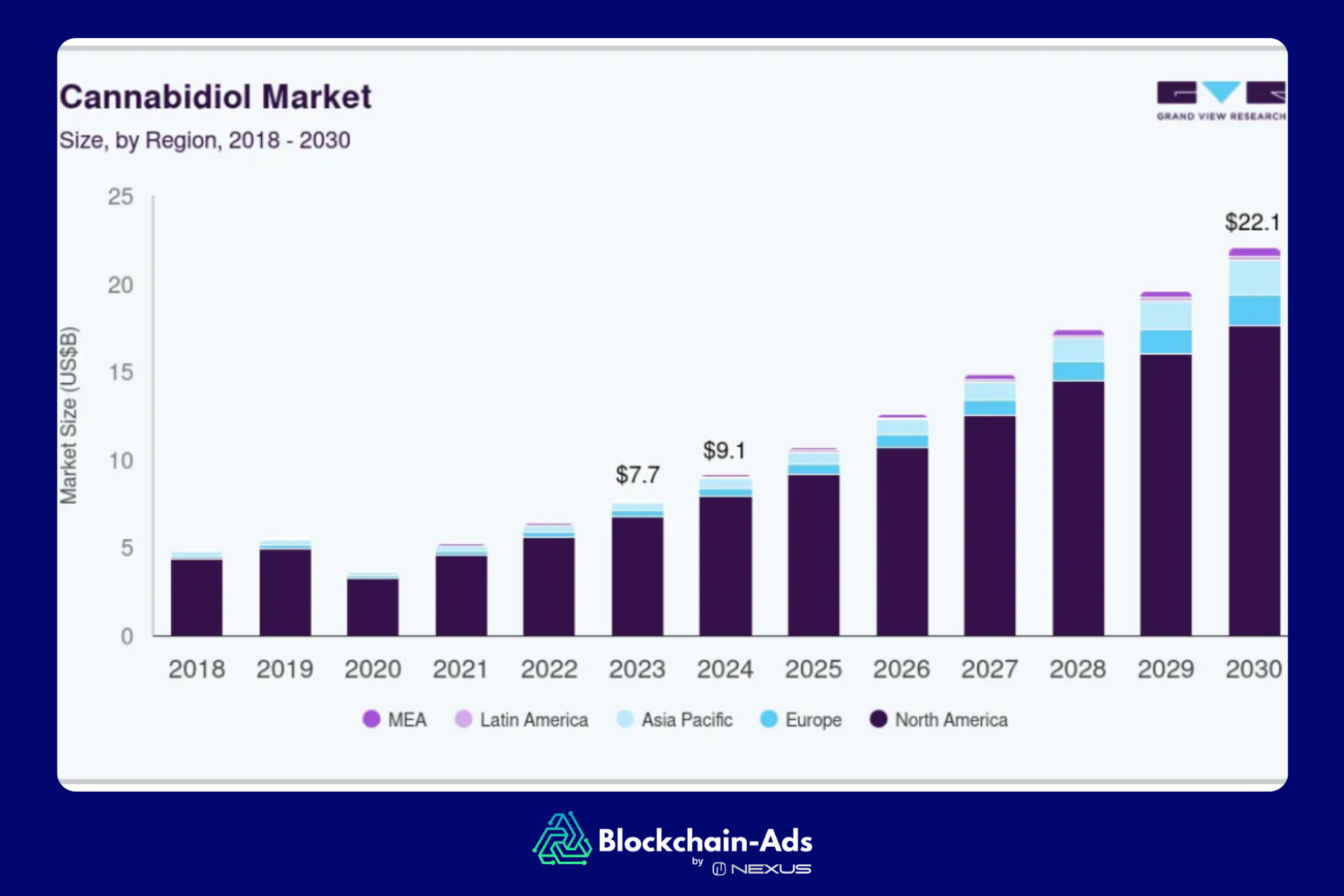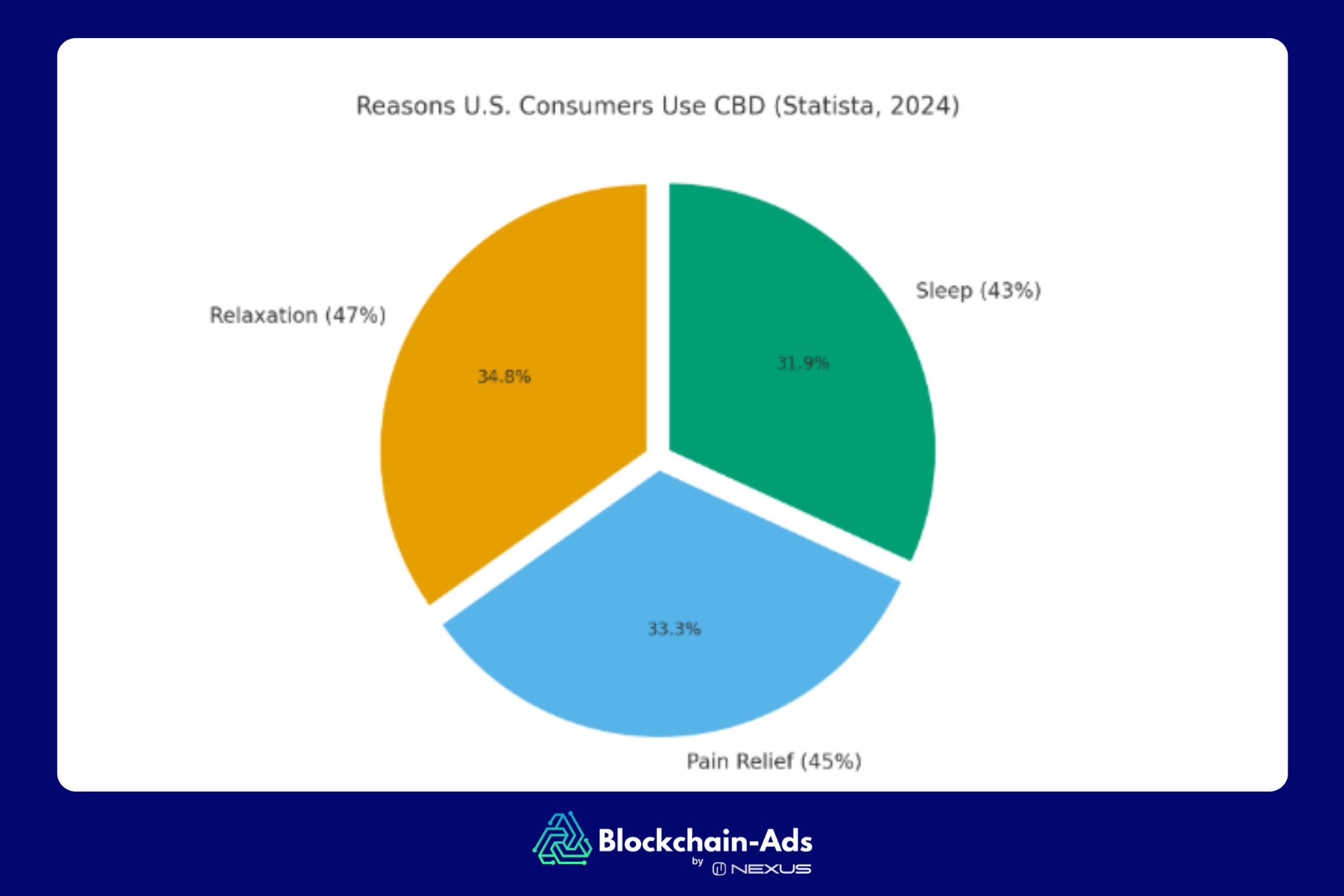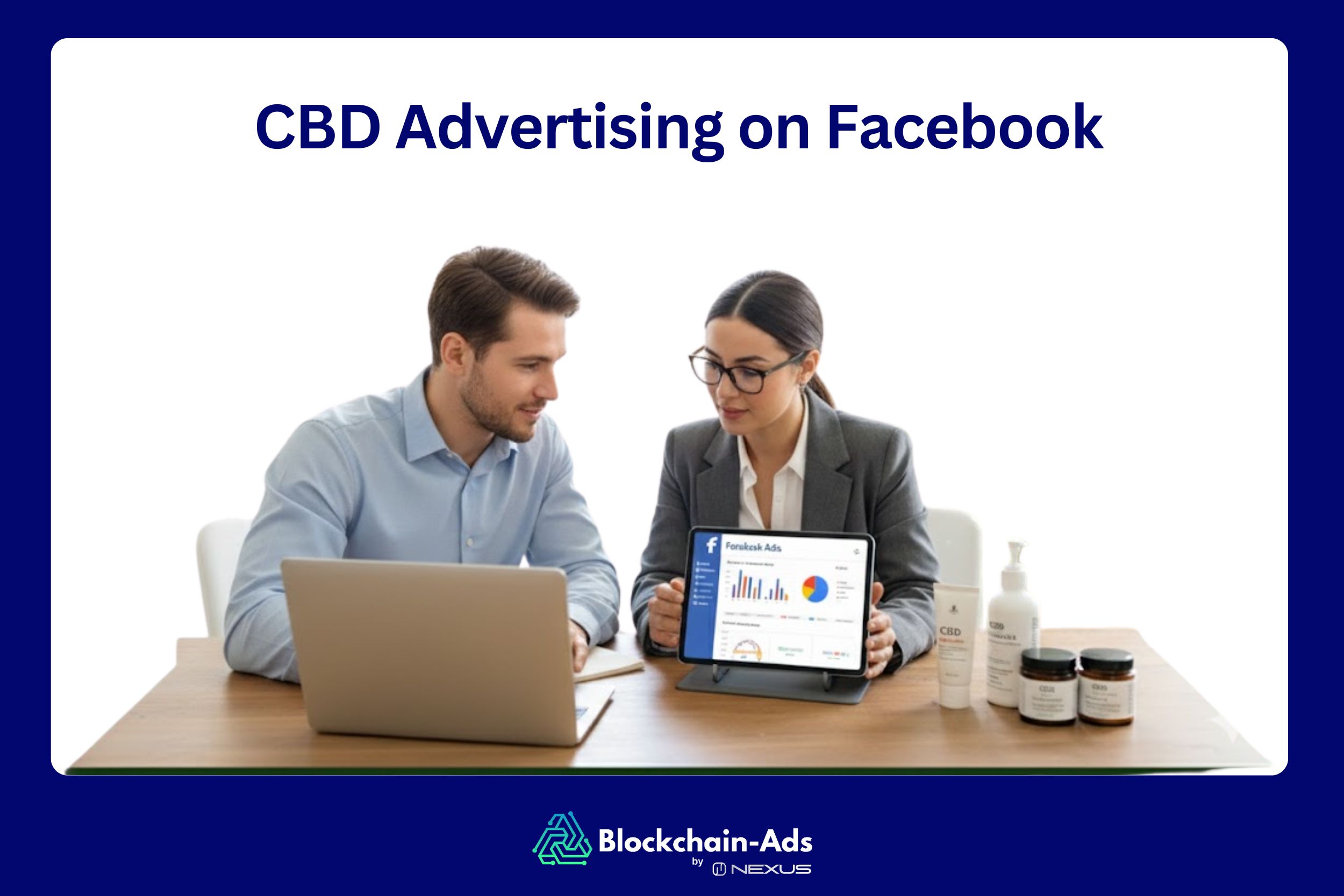Competitive Advantage in CBD: Definition & Importance
Heading
- Cointelegraph Formula offers various ad formats to 8 million monthly readers across 190+ countries, leveraging its trusted name in crypto.
Undeniably, it’s hard to stand out in a market where every brand swears their CBD oil is ‘’premium,’’ ‘’organic,’’ and lab-tested.’’ If you scroll platforms like Amazon or Instagram, you’ll see thousands of near-identical products fighting for the same attention. But the truth? Most CBD companies aren’t doing badly because of product quality, but rather because they lack a clear competitive advantage.
Usually, what separates the winners from the rest is the CBD marketing strategy. The way they position, communicate, and deliver trust to the customers. In an industry expected to reach $10.68 billion by the end of 2025 and grow over 15.8% annually through 2030, competition is high and rules are constantly changing.
So what actually differentiates a CBD brand? It all comes down to building a competitive edge. This guide, therefore, seeks to break down seven proven strategies that top CBD brands are using to outperform rivals.

What Is Competitive Advantage in the CBD Industry?
Competitive advantage refers to the approach a company takes to produce products and deliver services better and more affordably than its competitors. It’s that strategy that helps you stay profitable while others drown in discounts or disappear after a few quarters.
In traditional business theory, Harvard professor Michael Porter defined three main types of competitive advantage: Cost leadership, differentiation, and focus. Applying them in your CBD space starts to look a lot more real and practical.
In cost leadership CBD, you become the brand that delivers consistent quality at a lower price. Maybe you’ve optimized your hemp sourcing, own your extraction facility, or have a distribution efficiency that others can’t match.
For differentiation, you stand out because you’re different. Perhaps your products use rare cannabinoids like CBG or CBN. Or maybe you’ve built brand trust through radical transparency, showing every certificate of analysis upfront. In the focus strategy, you zero in on a specific market segment. It can be athletes, seniors, or pets that become the go-to brand for that specific audience.
Why Competitive Advantage Matters for CBD Brands
A few years ago, you could throw together a label, claim ‘’organic hemp,’’ and people would buy it. Nowadays, consumers are smarter, more skeptical, and spoiled for choice. And to survive in this market, you need more than a quality product— you need an advantage that keeps you relevant and trusted.
The market momentum is undeniable: the global CBD market hit $7.71 billion in 2023 and projects a 16.2% CAGR through 2030. This growth will attract thousands of new brands every year.
But growth doesn't guarantee success. Consumer expectations have evolved dramatically. Today, 52% of buyers say brand reputation is extremely important, and 62% refuse to purchase without accessible third-party lab results.
The opportunity is clear: 47% use CBD for relaxation, 45% for pain relief, and 43% for sleep. However, customers are filtering aggressively. If your brand lacks credibility, transparency, or consistency, you'll lose them to a competitor who delivers all three. When a brand lacks credibility, transparency, or consistency, then you’ll lose them to a competitor who can show all three.

That’s where competitive advantage comes in. It helps define how you deliver value, how you build loyalty, and how you justify your pricing when the market gets crowded.
Top 7 Strategies to Build Competitive Advantage in CBD
If you’ve been in the CBD business long enough, you already know how competitive the market is. New brands launch weekly, margins are tightening, and customers have become data detectives. They read COAs, compare milligrams per dollar, and fact-check your origin story before hitting that ‘’Add to cart.’’ button. So, to stand out when everyone claims to be ‘’premium’’ and ‘’organic’’, here are the strategies you need to consider.
1. Product Quality & Transparency – third-party lab testing & COAs.
In the CBD market, no certificate, no sale. A 2024 SingleCare survey found that 62% of CBD consumers only purchase from brands that make their third-party lab results public. That number alone tells you everything about modern psychology.
According to industry transparency experts, "In any industry where a product is manufactured and consumed, consumers expect superior product quality, transparency, and safety." This expectation is particularly critical in CBD, where regulatory oversight remains limited and consumer trust depends entirely on brand accountability.
CBD transparency is a business model. If your COAs aren’t easily accessible, up-to-date, and verifiable, then you’re instantly off the shortlist. Smart brands are even going beyond compliance. They’re embedding QR codes on every product, allowing buyers to instantly trace lab results. Some even publish batch history dashboards to prove purity and potency. When evaluating COA certificates, look for comprehensive testing that shows cannabinoid content, heavy metals, pesticides, and microbial testing to ensure product safety and quality.
2. CBD Brand Story & Trust – origin stories and reputation-building.
CBD is not only chemistry but also emotion. The best-performing brands like Charlotte's Web and Joy Organics have one thing in common. They lead with human stories. A Brightfield Group report 2024 found that 52% of CBD users rank ‘’brand reputation’’ as their top purchase factor, even above price or potency. That should be a great signal. If your story feels distant or corporate, people will scroll past. But if you show real roots— maybe a founder who discovered CBD while treating anxiety or a farm family committed to regenerative hemp, you’ll build authenticity.
3. Supply Chain Control (Seed-to-Sale) – ensuring consistency & purity.
Owning your CBD supply chain gives you something priceless, which is control. When you manage every step from hemp genetics to final bottling, then you remove uncertainty and establish long-term trust. Great brands with a seed-to-sale model, like Lazarus Naturals, maintain consistent quality and transparency because nothing is outsourced to question processors. Consistency basically builds reliability, and reliability builds repeat business, and that is what competitive advantage does.
4. Niche Market Domination – focusing on athletes, pets, seniors, etc.
The fastest-growing brands are dominating tight niches. For instance, the U.S. pet CBD market growth is projected to hit $1.1 billion by 2026. That’s a spot on for brands creating CBD chews, tinctures, and treats for pets with arthritis or anxiety. CBD athlete products are also booming, thanks to post-gym tinctures and topicals marketed around performance recovery. Meanwhile, senior-focused CBD brands are quietly scaling with mobility and sleep formulas. In simple terms, dominate one lane before expanding. Niche loyalty beats broad exposure every time.
To reach these niche audiences effectively, brands need precision targeting capabilities. CBDFX, for example, leveraged advanced audience segmentation on Blockchain-Ads to reach highly specific CBD consumer segments and achieve a 320% increase in ROAS.
5. Product Innovation & Unique Formulations – minor cannabinoids, adaptogens.
Standing out in a crowded field requires creativity. You can move beyond CBD oil and gummies and consider experimentation backed by science. Today, brands are shining with minor cannabinoids like CBN for sleep and CBG for focus, and customers are responding well. Forward-thinking brands are also infusing adaptogens (like ashwagandha or rhodiola) and functional mushrooms (like lion’s mane) for extra wellness benefits. In short, innovation means solving real problems better.
6. CBD Customer Education & Experience – blogs, dosage guides, responsive support.
Most people still don’t know how to use CBD correctly, and that is actually a confusion that can create an opportunity. A brand that teaches through blogs, short videos, email tips, and dosage calculators builds loyalty. In fact, educational content increases repeat purchase by up to 131% when paired with a retargeting campaign.
Education builds brand trust, but experience seals it. Of course, education only works if it reaches the right audience. Given CBD advertising restrictions on major platforms, brands increasingly rely on compliant programmatic advertising solutions designed specifically for regulated industries to distribute their educational content effectively.
7. Sustainability & Ethical Practices – organic farming, eco-friendly packaging.
A Deloitte sustainability study found that 57% of millennials and Gen Z buyers prefer brands using eco-friendly packaging and ethical sourcing. In CBD, that actually translates to organic farming, carbon-neutral shipping, and recyclable materials.
Some companies are even tracking their carbon offsets on blockchain. This is a move that blends transparency with accountability. Sustainability in CBD is therefore a good ethics as well as economics. Environmentally conscious CBD brands report 15-20% higher customer retention rates according to Brightfield Group. The reason is that people feel better buying from brands that care about more than profit.
How to Implement These Strategies in Your CBD Business
Having a solid plan on paper is one thing. Making it work in the real world is another. Let’s break down how you can actually apply these seven strategies inside your CBD business.
Strengthen product quality and transparency
Start with your sourcing. Make sure that you only work with certified hemp growers who provide complete traceability. Next, set up a partnership with a trusted third-party lab and make testing a non-negotiable part of your production process. Also, post your Certificates of Analysis (COAs) directly on product pages. Remember that 62% of buyers check lab results before purchasing. So this step directly builds trust and repeat business.
Develop a genuine story and build trust
Just tell the truth. If your company started because a family member found relief using CBD, say that. Use authentic language on your website and packaging. Also, collaborate with small influencers who actually use your product. Data shows that micro-influencers (under 50k followers) drive 60% higher engagement than celebrity endorsers in wellness niches due to their engagement rate.
Take more control of your CBD supply chain
It’s important to start by securing tighter partnerships with your growers and manufacturers. Be sure to create a written agreement that defines your quality standards. Use batch tracking software so that you can trace every product from harvest to shipment.
Dominate a niche market
It’s not worth it to sell to everyone. Maybe your CBD oil helps older adults manage joint pain. Or maybe your gummies are formulated for post-workout recovery. Select your lane and build authority around it.
Push innovation and product development
Try experimenting with minor cannabinoids like CBG or CBN because nowadays, consumers are moving fast towards functional blends. In short, these are products that serve more than one purpose. Keep an R&D budget aside (even 5-10% of profit) to test small batches before scaling up.
Invest in CBD customer education and experience
Education sells quietly and consistently. You can use blogs, video explainers, and FAQs to simplify topics like dosage, onset time, and product differences. Still, offer live chat or AI-powered assistants that respond instantly.
Commit to sustainability and ethical practices
Today’s buyers care about what happens behind the scenes. Switch to recyclable CBD packaging, reduce plastic, and source organically grown hemp. Even when you share your sustainability goals can make an impact.
Measuring Success: KPIs & Metrics for Competitive Advantage
It’s easy to say that your CBD brand has a competitive advantage, but how do you prove it? Here’s how you measure that.
- Repeat purchase rate (RPR): If people are coming back month after month, that is loyalty. You need to track how many customers reorder within 30, 60, or 90 days. If that number changes, look at where product consistency or customer experience has changed.
- Customer lifetime value (CLV): This tells you how much a single customer is worth over time. Higher CLV means your brand is nurturing long-term relationships. Aim for $150-$250 CLV per customer.
- Website conversion rate: An average CBD store converts around 2-3% of visitors. Meanwhile, top performers see 5-7%. Track conversions across product pages, education content, and checkout flows to identify what convinces customers to buy and what they hesitate over.
- Refund and complaint ratios: Low refund means that customers are satisfied with product quality and effectiveness. Keep this metric below 3% of the total orders.
- Marketing attribution accuracy: With limited tracking options due to privacy regulations and platform restrictions, accurate attribution becomes critical. Advanced solutions using blockchain-verified attribution can provide transparent, tamper-proof campaign performance data, helping CBD brands optimize ad spend with confidence.
Future Trends & Opportunities in the CBD Market
For brands that want to stay ahead of this growing and transforming market, the next wave of innovation will be about what’s next to CBD.
The rise of minor cannabinoids (CBG, CBN, CBC, and THCV)
CBD may be the major, but minor cannabinoids are quickly attracting users. Compounds like CBG (Cannabigerol) and CBN (Cannabinol) are preferred for their unique wellness effect. That is CBG for focus and gut health, and CBN for sleep support. Indeed, products featuring minor cannabinoids are expected to grow by over 65% year-over-year through 2027. This is as a result of more consumers seeking a more tailored effect beyond general relaxation.
Pet CBD: A Billion-Dollar Niche
Pet wellness is booming, and CBD is now part of that conversation. There are products for anxiety relief and joint support that are making pet owners turn to natural options. Statista projects the U.S. pet CBD market growth will reach $1.1 billion by 2026. This is driven by millennials and Gen Z, who treat pets like family. So, brands that develop CBD pet products will capture this loyalty-driven market before it becomes oversaturated.
Regulation Shifts
CBD regulatory compliance remains the biggest challenge and opportunity in the industry. Currently, the FDA still hasn’t fully formalized nationwide CBD guidelines. However, the momentum is building towards a clear framework. Once standardized federal rules are introduced (expected between 2025-2026), compliant brands with proper labeling, COAs, and safe dosage data will instantly gain legitimacy.
Sustainability and ethical sourcing
Consumers nowadays want to know where the CBD comes from. Eco-conscious practices like organic farming, biodegradable packaging, and fair-trade hemp sourcing are moving from nice-to-have to non-negotiable. A 2024 NielsenIQ survey found that 78% of the CBD target audience prefer brands with visible sustainable commitments, while 60% said they would pay more for products with verified ethical sourcing.
FAQ
What is a good example of competitive advantage?
A seed-to-sale operation gives CBD brands full control across cultivation, extraction, and distribution, ensuring consistent quality and cost efficiency. This vertical integration allows faster innovation, greater transparency, and flexibility to adapt to shifting consumer demands. By managing their supply chains internally, brands reduce disruptions and maintain reliability that third-party-dependent competitors often lack. Such control also enables sustainable sourcing and organic practices valued highly by modern, health-conscious buyers.
What are the 5 Porter’s competitive advantages?
Porter’s five forces—Supplier Power, Buyer Power, Competitive Rivalry, Threat of Substitution, and Threat of New Entry—explain how competition shapes industries. Each force influences profitability and guides strategic decisions for CBD brands seeking long-term success. Supplier and buyer power affect pricing, availability, and transparency expectations across the supply chain. Meanwhile, rivalry, substitutions, and new entrants demand constant differentiation through brand trust, innovation, and product quality.
What are the three competitive advantages?
The three main competitive advantages are cost leadership, differentiation, and focus, each defining a distinct way to outperform rivals. Cost leadership prioritizes efficiency by managing operations boldly and reducing overhead through strategies like vertical integration and bulk sourcing. Differentiation builds unique value through proprietary methods, superior quality, or personalized experiences that strengthen loyalty. Focus narrows attention to specialized markets—such as pet care or athletic recovery—where the brand becomes the go-to authority.
What is the biggest competitive advantage?
Reputation and brand trust form the most powerful competitive advantage in the CBD industry, where buyers rely on credibility more than price. Consumers depend on verified test results, authentic storytelling, and consistent product quality to make purchasing decisions confidently. Brands that prioritize transparency, ethical marketing, and responsive customer service earn lasting relationships. Over time, this reputation becomes a durable moat that new competitors cannot easily duplicate.
What are the 3 C’s of competitive advantage?
The 3 C’s—Company, Customer, and Competitor—create a holistic lens for evaluating and strengthening a CBD brand’s position. Company analysis reveals internal strengths such as technology, production efficiency, or brand identity that can drive unique value. Customer insights uncover evolving needs for quality, transparency, or affordability that shape buying behavior. Competitor analysis highlights market gaps where the company’s strengths can best meet customer priorities more effectively than others.
Qualify and get acess to Blockchain-Ads
Lorem ipsum dolor sit amet, consectetur
Quick Definition

Talk with some of our current partners
View all success stories

Reach 12M+
Engaged Web3 users across 10,000+ websites and 37 blockchains.






.png)





.png)
